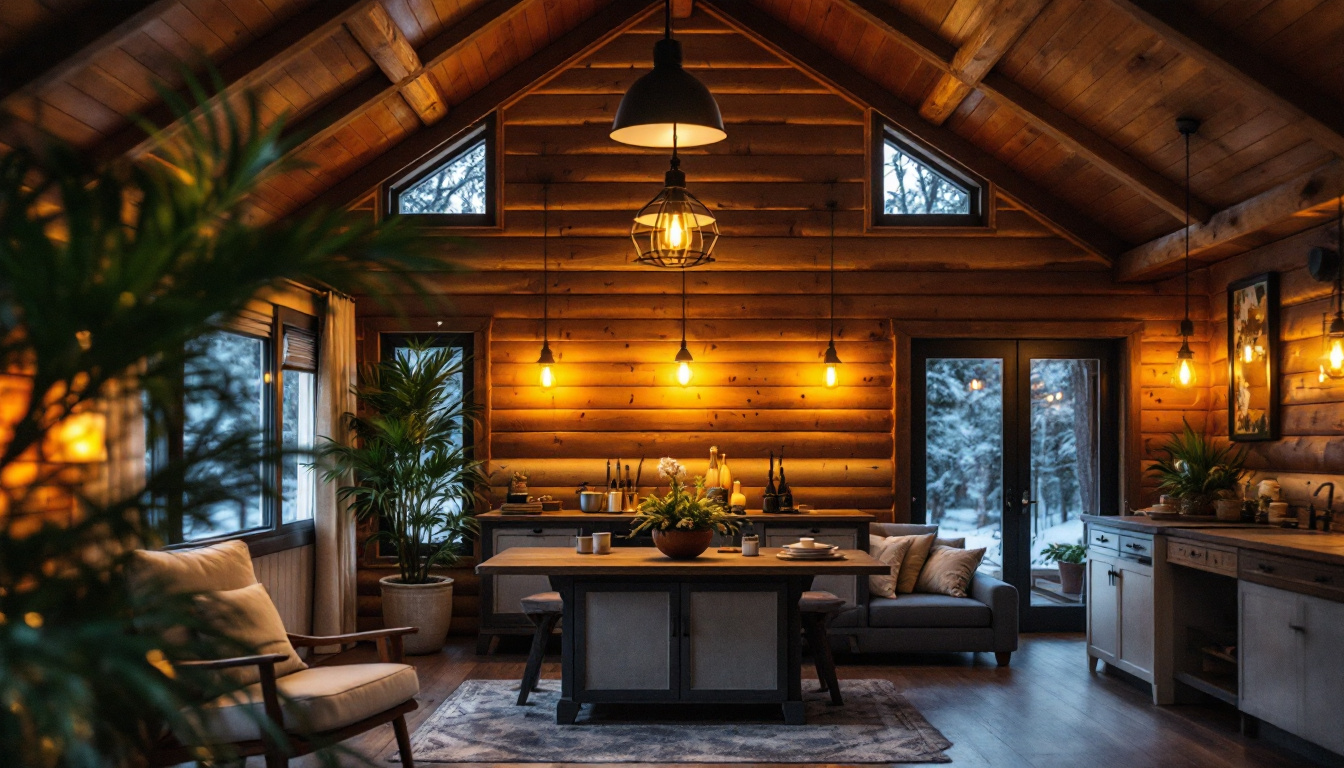
In the realm of lighting design, cabin lights hold a unique significance, particularly for lighting contractors. These fixtures not only enhance the aesthetic appeal of a space but also contribute to functionality and energy efficiency. Understanding the nuances of cabin lighting can empower contractors to make informed decisions, leading to satisfied clients and successful projects. This article delves into essential insights that every lighting contractor should consider when working with cabin lights.
Cabin lighting encompasses a variety of fixtures designed to illuminate spaces in cabins, lodges, and similar settings. These lights are not merely functional; they also play a crucial role in creating an inviting atmosphere. The right cabin lights can transform a rustic retreat into a cozy haven, making it essential for contractors to grasp the fundamentals of this specialized lighting.
When selecting cabin lights, contractors should be familiar with the various types available. Common options include recessed lighting, pendant lights, wall sconces, and track lighting. Each type serves a distinct purpose and can dramatically alter the ambiance of a space.
Recessed lighting, for example, is often used for a clean and modern look, providing a seamless integration into the ceiling. Pendant lights, on the other hand, can serve as decorative focal points, drawing the eye and adding character to the cabin’s design. Understanding the strengths and applications of each type is crucial for making informed decisions.
In addition to these common fixtures, contractors might also consider using LED strip lights for accentuating architectural features or creating a soft glow along staircases and pathways. These versatile lights can be tucked away in coves or under cabinets, providing both safety and aesthetic appeal. Furthermore, lantern-style fixtures can evoke a rustic charm, perfect for cabins that aim to maintain a traditional feel while still offering modern conveniences.
In today’s environmentally conscious market, energy efficiency is a top priority. Lighting contractors must be well-versed in energy-efficient options such as LED cabin lights. These fixtures not only consume less power but also have a longer lifespan compared to traditional incandescent bulbs.
Moreover, integrating smart lighting systems can enhance energy savings. These systems allow for remote control and automation, enabling clients to adjust lighting according to their needs and preferences. Educating clients about these options can lead to more sustainable choices and increased satisfaction.
Additionally, the use of dimmers can further optimize energy consumption while allowing for flexibility in mood and brightness. By installing dimmable fixtures, contractors can help clients create a range of atmospheres, from bright and lively during social gatherings to soft and intimate for quiet evenings by the fire. The combination of smart technology and dimming capabilities not only promotes energy efficiency but also elevates the overall experience of cabin living.
Effective cabin lighting design requires a thoughtful approach. Contractors must consider both the functional and aesthetic aspects of lighting to create a harmonious environment. This section explores key design principles that can guide contractors in their projects.
One of the most effective strategies in cabin lighting design is the use of layered lighting. This involves combining ambient, task, and accent lighting to achieve a balanced and versatile illumination scheme. Ambient lighting provides overall illumination, while task lighting focuses on specific areas, such as reading nooks or kitchen counters. Accent lighting, on the other hand, highlights architectural features or artwork.
By employing layered lighting techniques, contractors can enhance the functionality of a space while also creating visual interest. This approach allows for flexibility, enabling clients to adjust the lighting according to different activities or moods. For instance, during a cozy evening with friends, the ambient lighting can be dimmed while accent lights highlight a beautiful piece of art, creating a warm and inviting atmosphere. Additionally, incorporating dimmer switches can further enhance this versatility, allowing for a seamless transition from bright, energizing light during the day to softer, more intimate lighting in the evening.
The color temperature of cabin lights can significantly influence the overall feel of a space. Measured in Kelvin (K), color temperature ranges from warm (around 2700K) to cool (above 5000K). Warm light creates a cozy and inviting atmosphere, ideal for relaxation, while cooler light can enhance focus and productivity.
Contractors should consider the intended use of each space when selecting color temperatures. For example, a cabin living room may benefit from warm lighting to promote comfort, while a workspace might require cooler tones to enhance concentration. Striking the right balance can elevate the cabin’s ambiance and functionality. Furthermore, the use of smart lighting technology can allow homeowners to easily switch between different color temperatures throughout the day, adapting to natural light changes and personal preferences. This not only maximizes comfort but also contributes to energy efficiency, as homeowners can optimize their lighting according to their needs and the time of day.
Once the design phase is complete, the focus shifts to installation. Proper installation is crucial for ensuring the longevity and effectiveness of cabin lights. This section outlines best practices that contractors should adhere to during the installation process.
Safety should always be the top priority when installing cabin lights. Contractors must adhere to local electrical codes and regulations to ensure a safe and compliant installation. This includes using appropriate wiring, circuit breakers, and fixtures that are rated for the specific environment.
Additionally, it is essential to consider the location of light fixtures. Proper placement can prevent hazards, such as glare or excessive heat, while also enhancing the overall effectiveness of the lighting design. Taking the time to plan the installation carefully can save time and resources in the long run.
After installation, testing the lighting is essential to ensure everything functions as intended. Contractors should conduct thorough checks to confirm that all fixtures are operational and that the lighting meets the design specifications. This includes adjusting dimmers, verifying color temperatures, and ensuring that the light distribution is even throughout the space.
Clients should also be involved in this process, as their feedback can provide valuable insights. Making adjustments based on client preferences can lead to greater satisfaction and a more successful project outcome.
Staying updated on current trends in cabin lighting can give contractors a competitive edge. As design preferences evolve, so do the technologies and styles associated with cabin lighting. This section highlights some notable trends that contractors should be aware of.
In recent years, there has been a growing preference for natural materials and finishes in cabin lighting. Fixtures made from wood, stone, or metal can complement the rustic charm of a cabin while adding a touch of elegance. These materials not only enhance the aesthetic appeal but also promote a connection to nature, which is often a key aspect of cabin living.
Contractors should consider incorporating these materials into their lighting designs, as they can resonate well with clients seeking a harmonious blend of comfort and style. Custom fixtures that reflect the natural surroundings can also create a unique and personalized touch.
The rise of smart home technology has extended to cabin lighting as well. Smart lighting solutions allow for greater control over lighting settings, enabling users to adjust brightness, color, and even schedules via mobile devices or voice commands. This technology not only enhances convenience but also contributes to energy efficiency.
Contractors should familiarize themselves with various smart lighting products and systems, as clients may increasingly seek these options for their cabins. Offering smart lighting solutions can differentiate contractors in a competitive market and meet the evolving needs of clients.
Effective communication with clients is essential throughout the lighting design and installation process. Educating clients about their options, the benefits of different fixtures, and maintenance requirements can foster trust and lead to successful projects.
When discussing cabin lighting options, contractors should provide clear and concise information. This includes explaining the differences between various types of fixtures, energy efficiency ratings, and installation requirements. Providing visual aids, such as diagrams or mood boards, can help clients visualize the final outcome and make informed decisions.
Additionally, contractors should be prepared to answer questions and address concerns. Open communication can help build a positive relationship with clients, ultimately leading to repeat business and referrals.
After the installation is complete, ongoing support can enhance client satisfaction. Contractors should offer guidance on how to operate and maintain the lighting systems effectively. This may include providing information on bulb replacement, cleaning procedures, and troubleshooting common issues.
Establishing a follow-up process can also demonstrate commitment to client satisfaction. Checking in after the project is completed can provide valuable feedback and opportunities for future work.
Cabin lights play a pivotal role in creating inviting and functional spaces. For lighting contractors, understanding the intricacies of cabin lighting—from design principles to installation best practices—can lead to successful projects and satisfied clients. By staying informed about trends and technologies, contractors can offer innovative solutions that meet the evolving needs of their clientele.
Ultimately, effective communication and client education are key components of a successful lighting project. By fostering strong relationships and providing exceptional service, contractors can position themselves as trusted experts in the field of cabin lighting.
Ready to elevate your cabin lighting projects with premium fixtures that blend quality, affordability, and convenience? Look no further than LumenWholesale. Our spec-grade lighting selection is designed to meet the highest industry standards, ensuring you deliver reliable and high-performance lighting solutions to your clients. With unbeatable wholesale prices and the convenience of free shipping on bulk orders, you can access the best value without the hassle of hidden fees. Discover wholesale lighting at the best value today and light up your projects with confidence.

Discover essential tips and strategies for lighting contractors to navigate common challenges with Sylvania Light Bulb Company products.

Discover how outdoor solar powered lights can enhance your business profitability in this comprehensive guide tailored for lighting contractors.

Discover why understanding light bulb base sizes is crucial for lighting contractors.

Discover how solar-powered outdoor pendant lights are revolutionizing the lighting industry for contractors.